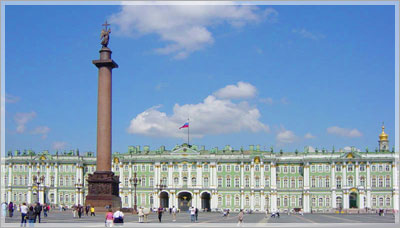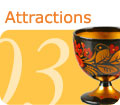The Winter Palace

Magnificently located on the bank of the Neva River, this Baroque-style palace is perhaps the major attraction of St. Petersburg.
Many visitors also know it as the main building of the Hermitage Museum (which consists of six buildings). The green-and-white three-storey palace is truly impressive: it has 1786 doors, 1945 windows and 1057 halls and rooms, many of which are open to the public.
The Baroque Winter Palace was built in 1754-62 for Empress Elisabeth, daughter of Peter the Great. By the time it was completed Elisabeth had already died, and only Catherine the Great and her successors could enjoy their new home.
Designed by Bartolomeo Rastrelli, the Baroque-style, green-and-white palace has 1786 doors and 1945 windows and 1057 halls and rooms, many of which are open to the public. Many visitors also know it as the main building of the Hermitage Museum (which consists of six buildings).
The Palace is now part of a group of magnificent buildings that is called the State Hermitage Museum which holds one of the world's greatest collections of art. As part of the Museum, many of the Winter Palace's 1057 halls and rooms are open to the public. The Military Gallery, opened in 1826, accommodates 332 portraits of military leaders of the Russian army during the Napoleon's invasion of Russia.
From the 1760s the Winter Palace was the main residence of the Russian Tzars.
The Shadow of the Winter Palace recounts an extraordinary century of Russian history, a politically tempestuous time that was also a Golden Age of intellectual and artistic achievement-the century of Dostoevsky and Tolstoy, of Rimsky-Korsakov and Tchaikovsky. During Revolution it was the scene of many demonstrations and then was used as a hospital.
It is in the old Winter Palace (1754-1764, work of Rastrelli) that the greatest artistic masterpieces are presented under the name of Museum of the Hermitage. This old palace is of style baroque, on three floors. The Museum of the Hermitage, first museum of Russia, shelters 2 700 000 works of art including 67 000 exposed in 400 rooms.
Many of the impressive interiors have been remodeled since then, particularly after 1837, when a huge fire destroyed most of the palace.
Nowdays the Winter Palace, together with four more buildings houses the extensive collections of the Hermitage. The Hermitage Museum is the largest art gallery in Russia and is among the largest and most respected art museums in the world.
The present structure, completed in 1762 and designed by Bartolomeo Rastrelli, was commissioned by the Empress Elizabeth. Its opulent baroque facade, stretching two hundred meters, is a veritable cornucopia of pilasters, bays, and statuary.
The palace served as the winter residence for every ruler of Russia since Peter I, who installed himself there along with his mistress, the Countess Vorontsova.
After his wife Catherine the Great seized the throne, she redecorated and appropriated her husband's old quarters. While her son Nicholas I lived in a modest apartment there, his wife Alexandra commissioned the famously luxurious Malachite Room, later to be used as the meeting place for Kerensky's Provisional Government.
Nicholas II had his quarters immediately above this room until 1904, when he moved from the increasingly discontented capital to Tsarskoe Selo. In July of 1917, the Provisional Government took up residence here, thus setting the stage for the October Revolution. After consolidating its power, the Bolshevik government transferred its capital to Moscow, and since that time the Winter Palace has been associated primarily with its role as the Hermitage Museum.
In the middle of the Palace Square is the Alexander Column erected in 1830-1834 after a design by Auguste Montferrand. Both the Column and the General Staff Arch commemorate the Russian victory over Napoleon in the 1812-1814 war.
The Column is hewn from a cliff that was found in a bay in the Gulf of Finland. The 230-ton monolith was carved away by hand for three years and then brought to St.Petersburg in a barge built specially for that purpose. Two thousand soldiers rolled it onto a high pedestal with the help of a very intricate system. It is not attached to the pedestal but is securely held in place by its huge weight.
The figure of an angel on top symbolizes the peace that settled on Europe after the victory over Napoleon. Rising to a height of 47.5 metres the Column outshines the Trojan Column in Rome and the Vendome Column in Paris.
Palace Square has witnessed many historical events. It was the scene of the "Bloody Sunday" massacre. And it was from this place that revolutionary soldiers and sailors stormed the Winter Palace on an autumn night in 1917. The cobblestones in the middle of the square have been pre-served as they were in October 1917 as a reminder of that historic event. On national holidays, demonstrations are held in Palace Square. All through the year it is packed with tourist buses.





